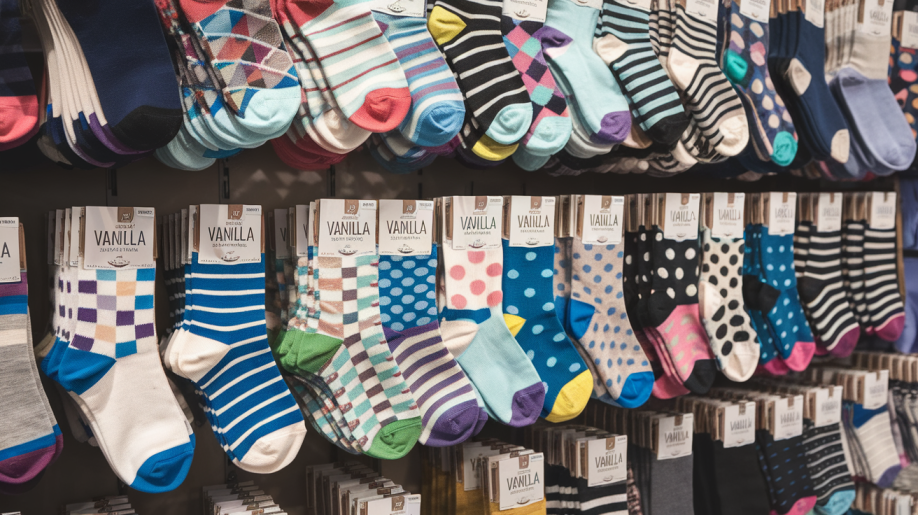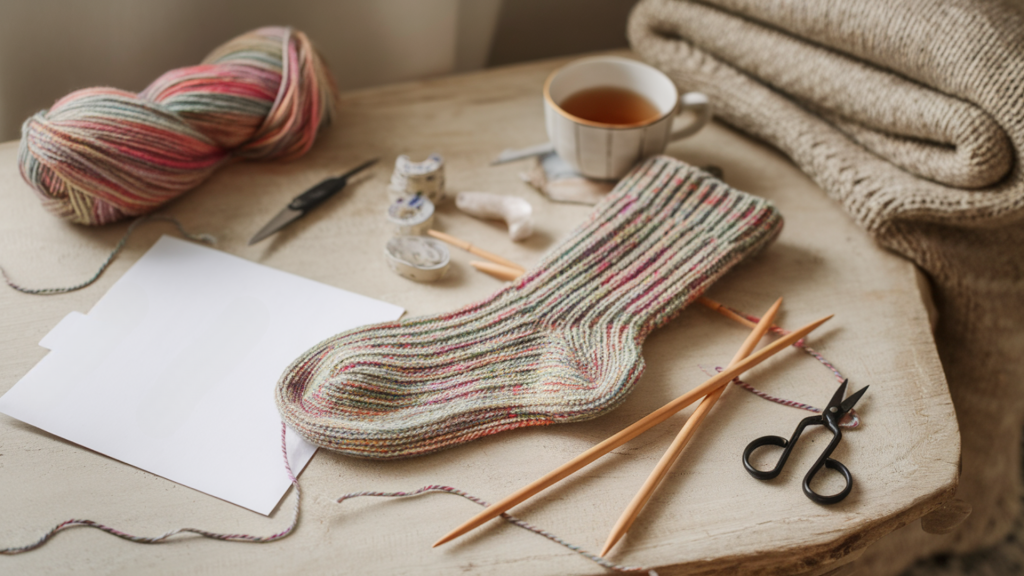I love knitting as a hobby, but when I need to relax at the end of a busy day, nothing feels better than making a Vanilla sock. It’s so calming to watch each stitch come together and create a cozy piece of art.
My love for these socks grows every time I slip on a pair I’ve made—they’re great for beginners and experts. Once you explore their simple, fun experience , you’ll never look at socks the same way again.
Each sock has its own story and holds the warmth of your hands, something store-bought socks can’t do. By the end of this guide, I promise you’ll be as excited as I am to make Vanilla socks part of your daily routine.
Grab your needles—it’s time to make your feet happy!
What Is a Vanilla Sock?

Knitting vanilla socks is one of my favorite hobbies.
When I first heard about vanilla socks, I was confused, too. No, they don’t smell like cookies – they’re just the basic sock design you can knit.
I think vanilla socks are the reliable family car of the sock world – not flashy, but they’ll never let you down. They’re also perfect for beginners and a comfy choice for skilled knitters.
These are simple socks without fancy patterns or tricky stitches. It’s just good, solid footwear that won’t make you want to give up halfway through making them.
Why I Prefer Knitting Vanilla Socks?
Let me share why I keep coming back to vanilla socks like they’re an old friend.
First, they’re calming to make. The simple pattern becomes almost automatic, letting my mind wander while my hands stay busy. This is perfect for those nights when I’m too tired to count stitches for a harder pattern.
I like how vanilla socks let the beautiful yarn be the star, when I spend extra on pretty yarn (don’t tell my partner!), a simple pattern best shows off those gorgeous colors.
They work for everyone, too – my brother-in-law would never wear fancy socks, but he loves his plain vanilla ones.
I’ve found that vanilla socks also wear out more evenly than fancy ones. Nothing’s worse than getting a hole in your special socks after just a few wears.
Most importantly, vanilla socks fit well. Fancy patterns sometimes looks nice but feel awful. Vanilla socks are comfy and reliable.
My Basic Recipe for Vanilla Socks
Many users may find the whole process of creating your first-ever vanilla sock quite overwhelming (been there).
But trust me when I tell you this: it is easier than feeding your infant (don’t take this literally; it has its challenges, too).
Like any good recipe, sock knitting needs certain things:
- Sock yarn (look for “fingering weight” or yarn that says it’s for socks)
- Small knitting needles (sizes 1-3) that look super tiny
- A tape measure
- Scissors
- A yarn needle for finishing
I suggest picking yarn with some wool for strength and stretch, though cotton blends work well for people who find wool itchy.
The Method I Use for Vanilla Socks
Everyone has a personalized recipe to use for starting with their sock knitting process, however, I found this method the easiest. There is no one-size-fits-all approach to knitting, but this will help most people start.
You can make your changes after learning more about this process, which will make your sock design stand out.
Let’s break this down into five main parts – think of it as the sock version of a five-step plan:
Cuff
I start at the top of the sock with a stretchy band. This keeps the sock from sliding down, which is super annoying.
I usually knit a ribbed pattern for about 1-2 inches. This makes it stretchy without being too tight, as nobody wants their sock to squeeze their leg too hard.
Leg
Next comes the straight part that goes down the leg. The length is up to you – make them knee-high if you want or ankle-length if you’re in a hurry.
For everyday socks, I find a 6-7-inch leg that works well. It’s not too short or tall, just right—like in Goldilocks!
Heel
Beginner knitters often get stuck at the heel. This is the turn that makes the sock fit your foot shape.
I like making a heel flap and gusset because it fits most foot shapes well. Think of it as the sock version of stretchy pants – comfy and forgiving.
Foot
After turning the heel (maybe do a little happy dance here), I work on the foot part until it reaches where the toes begin. This part is easy but needs good measuring.
I always measure the person’s foot or use size charts. Nothing’s worse than socks that are way too short or too long!
Toe
Finally, I shape the toe by making it smaller in a pattern, then close it up with a special stitch. It sounds hard but gets easier with practice.
This smooth toe feels better. Your toes don’t deserve to rub against bumpy seams all day.
Trendy Patterns for Your Vanilla Sock that Stay Simple
Even with basic socks, you can add your personal touch. It’s like sprinkling on vanilla ice cream – still vanilla, just more fun.
Here are my top picks on the things you can try:
- I often add stripes by changing yarn colors every few rows. Non-knitters think this is super impressive, but it’s easy!
- Colorful yarns create beautiful effects without extra work – the yarn decorates while you get all the praise.
- For a cool look, I sometimes make the cuffs, heels, and toes a different color. This uses leftover yarn bits while making you look like a sock design genius.
Easiest Vanilla Sock Designs for Beginners
There are many whacky and beautiful designs to choose from, but as a person who hates working hard (some might relate to this), I prefer choosing the easy way out, and you may prefer this as well.
When teaching friends to knit socks, I suggest these easy designs:
-
The “Basic Vanilla” – one solid color from top to bottom. This lets you focus on learning without worrying about color changes or running out of yarn.
-
The “Two-Color Wonder” uses one color for the cuff and heel and another for the leg and foot. This breaks up the knitting while keeping it easy and makes it look like you worked harder than you did.
-
The “Self-Striping Shortcut”—Special striping yarn changes colors as you knit for those who want cool patterns with minimal effort. It’s like having the yarn do the hard work for you!
My Tips for Successful Sock Knitting
I always measure carefully before starting. A good-fitting sock feels so much better. Trust me – I made socks so tight they barely fit on my foot!
I try to keep my tension the same throughout. My first pair had a huge cuff and a tiny foot. Oops!
I use stitch markers (little rings that slide on your needle) to track where I am. They’re like little helpers that keep you from getting lost.
Conclusion
Knitting vanilla socks is a simple, relaxing, and rewarding craft. Whether you’re a beginner or an experienced knitter, these socks offer comfort, durability, and endless ways to get creative.
I prefer making my own socks because of the comfort they offer me.
It is a fun activity and ensures that you are only using the finest quality material. No cheap third-party socks are marketed as handmade knitted socks.
With the right yarn, proper sizing, and a little practice, you can make a handmade pair that fits like a dream.
So grab your needles, pick your favorite yarn, and enjoy.
Frequently Asked Questions
How Do I Prevent Holes at The Heel?
Keep your yarn tighter at the corners and pick up stitches carefully in the gusset. Be extra careful at the sock’s weak spots.
How Do I Know What Size to Make?
Measure the foot at its widest part and make the sock smaller to hug the foot. Socks are like good friends – supportive without being too clingy.
What if I Don’t Have the Right Needles?
You can use a long circular needle, two circular needles, or tiny circular needles made just for socks. The sock doesn’t care how it gets made!
How Do I Wash Hand-Knit Socks?
I wash mine by hand with mild soap and lay them flat to dry. It’s a bit of extra work, but they’ll last much longer this way.
What’s the Best Yarn for Long-Lasting Socks?
A wool blend with a bit of nylon is great for durability. Wool keeps feet warm, while nylon strengthens to prevent holes and wear.









